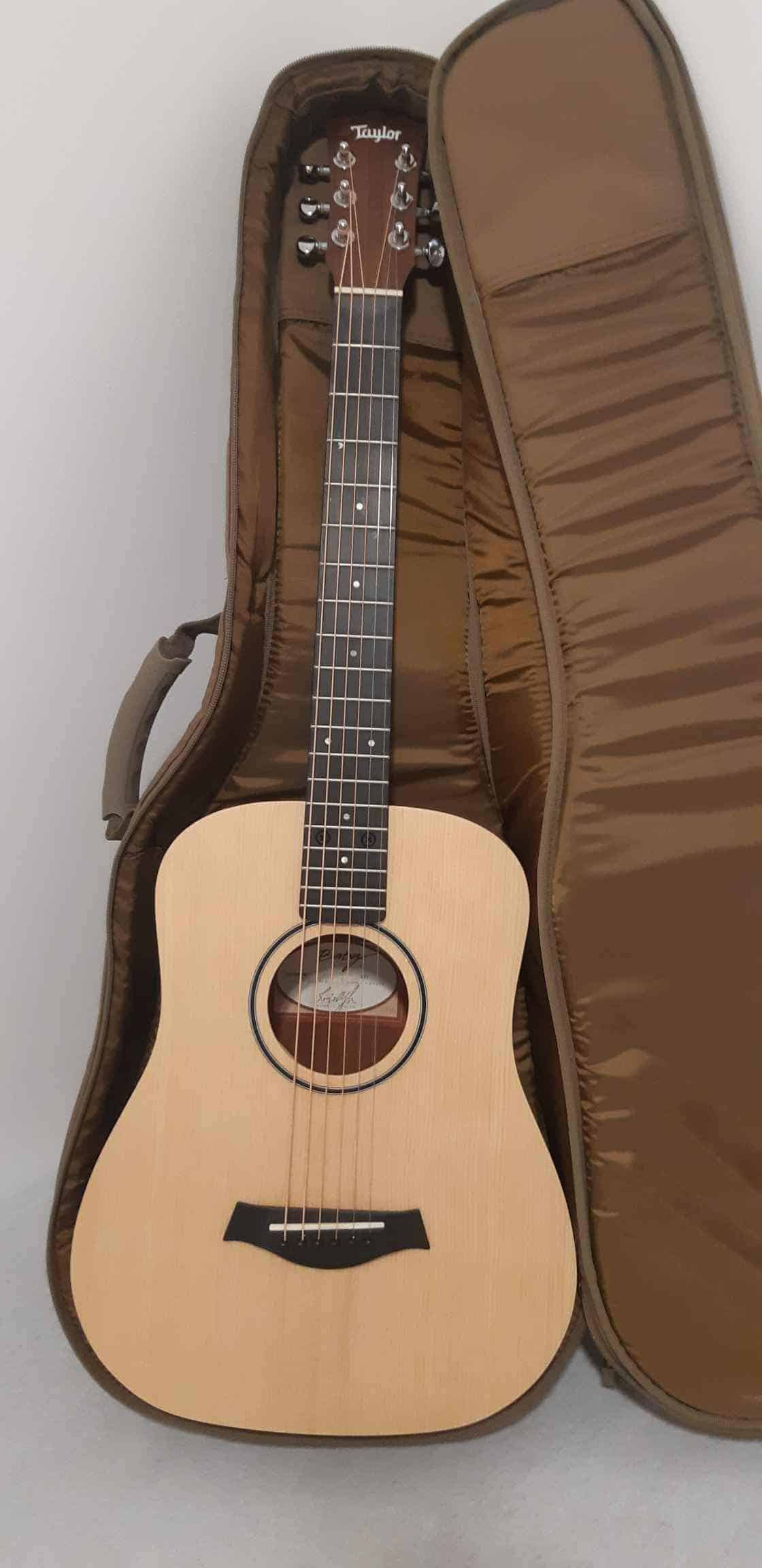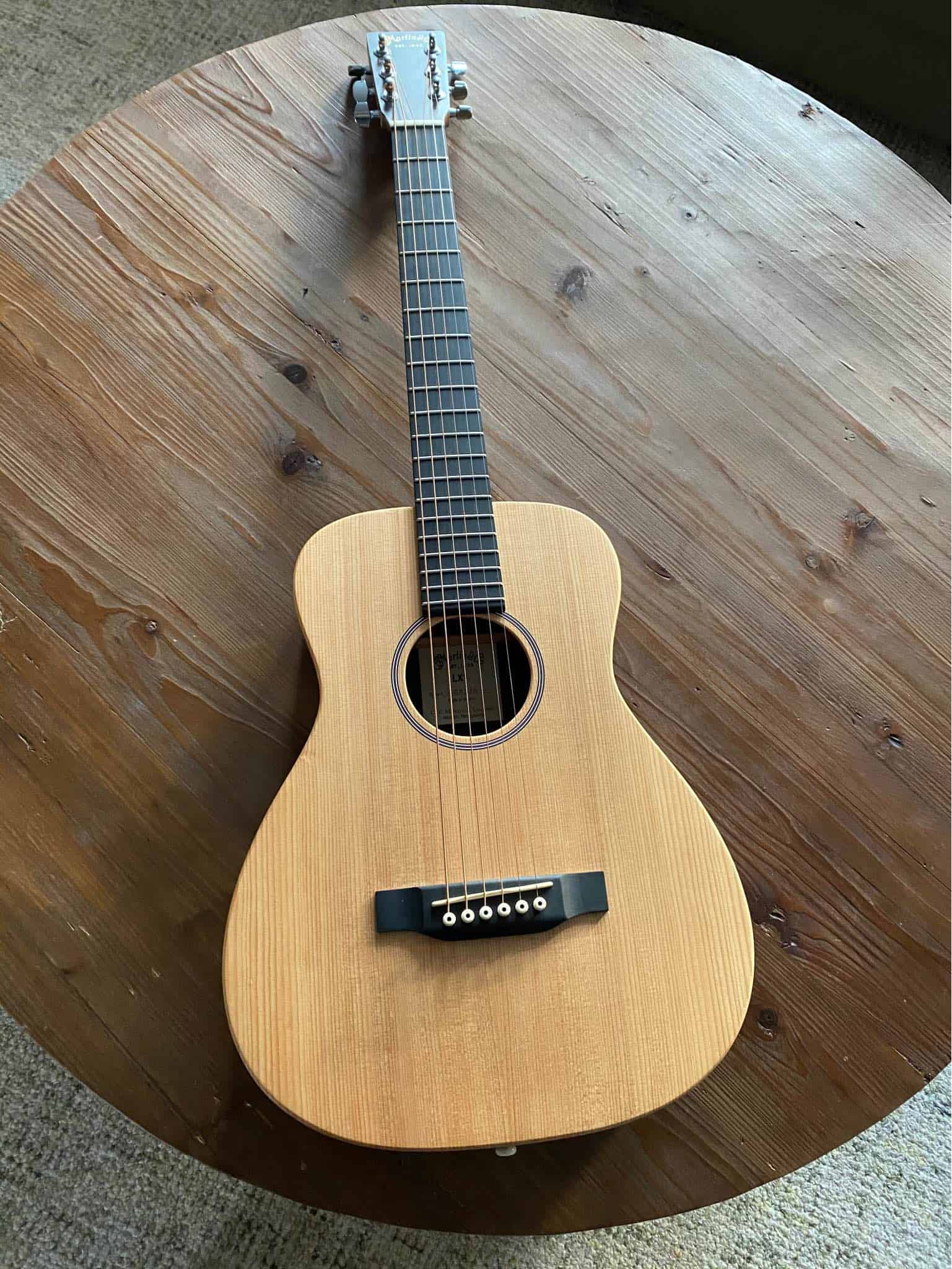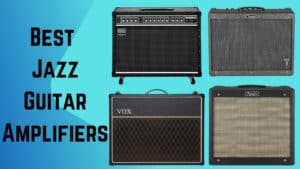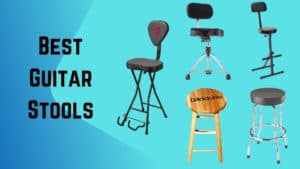Baby Taylor vs. Little Martin (LX1) – Compared, Reviewed, and Rated
The Baby Taylor vs. Little Martin is a neck-to-neck fight. They are two smaller body acoustic guitars from the best names in the business. Both guitars – the BT2 and LX1 - feature in every “best travel acoustic guitar” list out there, and for good reason.
Martin & Co. is the OG of acoustic guitars. On the other hand, Taylor guitars are relatively younger. But they are equally cherished for their distinctive tone and superior build quality. Both brands have diehard fans (read: cult following), for whom this would be an easy choice.
Others need to figure out what is similar and different and translate that to match their needs and style. That's the best way to know if you are getting your money's worth. Here, we will go through a comprehensive comparison of Little Taylor and Little Martin.
Table of Contents
Baby Taylor vs. Little Martin: 5 Key Differences
- Body Shape: Baby Taylor - ¾ size dreadnought guitar. Little Martin - modified-0 shape.
- Baby Taylor has a laminate wood neck. Little Martin has a composite neck.
- Baby Taylor has an Ebony fingerboard. Martin has a Richlite fingerboard.
- The build quality of Martin is more robust than the Baby Taylor. Taylor has better tonewood, especially the ebony fingerboard and bridge.
- Baby Taylor sounds full and deep. Little Martin is crisp and rich.
They are beautiful acoustic guitars, each worthy of its own post. We won’t decipher if the Baby Taylor or Little Martin is “better.” Instead, let us objectively break down the two mini acoustics to see which one is right for you.
Little Martin Overview:
True to its name, the Little Martin is the smallest guitar in the Martin & Co. catalog. It is, as the brand claims, small in size but big on tone and versatility. The LX1 is ideal as a practice guitar for students or a travel acoustic for campfire sessions. The Little Martin is sold in four models:
- LX1
- LXK2
- LX1R
- LX Black
We will use the LX1 for this post to keep things simple. The Little Martin LX1 features a Solid Spruce Top with mahogany back and sides in modified-0 body size. The body is made from high-pressure laminate.
The LX1 has a 23” scale length and modified-0 body size. The Birch laminate neck is topped with a Richlite® fingerboard and hosts 20 frets. For an additional cost, you can opt for the acoustic-electric version with Fishman Sonitone electronics.
Baby Taylor Overview:
The Baby Taylor is a compact dreadnought acoustic guitar (3/4 size) with a smaller scale. It was launched in 1996 and is sold in several versions. The enduring popularity vouches for its brilliant sound and musicality.
- Popular ¾ size dreadnought acoustic guitar
- A premium travel guitar or student guitar
- Ideal instrument for guitarists with small hands
- A cost-effective entry into the "Taylor realm"
The Baby Taylor generally sports a Mahogany top and layered Sapele back and sides. The mahogany neck is scarf-jointed to the body and topped with an ebony fingerboard. You can find several versions of the guitar. They differ with regards to tonewood and electronics i.e., with or without the ES-B pickup system.
The Baby Taylor has become a modern classic and a popular choice among beginners who can spare cash. According to Taylor, it is not a budget guitar. Despite the modest price, it has the iconic Taylor sound and playability.
It is a no-frills acoustic. So, you won’t find inlays, binding, or even a truss rod cover. This helps Taylor keep the costs down without skimping on components that matter. Either way, it’s a highly affordable entry point to the premium guitars.
Little Martin vs. Baby Taylor: Comparison Table
Features and Specs | Little Martin (LX1) | Baby Taylor (BT2) |
Body Shape | Modified-0 | ¾ Dreadnought guitar |
Top | Solid Sitka Spruce | Solid Mahogany |
Back & Sides | High Pressure Laminate Mahogany | Sapele Laminate |
Frets | 20 | 19 |
Baby Taylor vs. Little Martin – Acoustic Guitar Shootout


Build and Tonewoods
The tonewoods are the biggest difference. It will be a big factor in your decision as there is a direct impact on the tone. Martin LX1 has a solid Sitka Spruce top with an HPL mahogany body. Baby Taylor features a solid Mahogany top with laminated Sapele back and sides. Mahogany is known to be warm and mellow and spruce is more punchy and bright.
Secondly, the Little Martin features a Rust Birch neck topped with a Richlite fingerboard, which they say is an eco-friendly composite. It could be marketing speak for a cost-cutting measure. Either way, the neck or fingerboard doesn't detract from the quality of the Martin LX1. Baby Taylor doesn’t skimp in this regard. It has a plush African ebony fingerboard and bridge.
Features and Components
I have picked the models without electronics but we will discuss the acoustic-electric versions briefly (BT2e and LX1e). Both guitars have the same quality of hardware such as die-cast chrome tuners, synthetic bone nut/saddle, single ring rosette, and black bridge pins.
They look and feel premium and are easy to handle while sitting or standing. Each guitar holds its tuning well. The fretwork and intonation are also spot on. Taylor has an ebony bridge compared to Little Martin’s Richlite. In theory, Baby Taylor is better on paper. But I don’t think it makes enough of a difference in tone to matter. In fact, after playing Martin LX1, I’ve come to appreciate Richlite.


Playability and Size:
These two mini acoustic guitars have a non-cutaway design. The main difference is the scale length and body shape. The Little Martin has a modified-0 shape with a 23” scale. Baby Taylor has a ¾ dreadnought shape with a 22.75” scale. Whether you are a young adult or a six-footer, both guitars are equal in comfort and playability. If you are of short stature, you may prefer the Little Martin, but the difference is not a deal-breaker (or maker).
Tone and Sound:
Sound is something you should pay attention to as there is a sizeable difference. Taylor, thanks to the shape and arched back, sounds full and deep. Little Martin sounds crisp with more amenable highs but less resonant. As I said, the Baby Taylor sports an arched back. It rounds out the sound beautifully and improves the projection/volume of the guitar. It comes to life when you work it with strumming.
Little Martin has more clarity and note definition for fingerstyle playing. It has a classy brightness to it. Plus, the body style is also more suitable for intimate and responsive playing. Neither guitar sounds tinny or harsh. So, whether you strum or fingerpick, both can serve your needs. But there is a tangible difference in tone, which may make your decision easy.
Price and Value
Baby Taylor and Little Martin are both fantastic acoustic guitars. Either guitar is acceptable as they are backed by high-end brands and priced under $400. Both ship with a gig bag of the same quality. Plus, they have the sound, playability, and build quality you expect in this price range.
The difference in cost is minuscule. If I was forced to nitpick, I would say that Baby Taylor offers better value in terms of components due to the arched back design, ebony fretboard and bridge, and the gig bag. Of course, some of that is colored by personal preference.
Baby Taylor and Little Martin: Video Comparison
Subtle differences in sound and tone are tricky to capture in words. Let’s fall back on this YouTube video comparing the Little Taylor and Baby Martin
Final Verdict: Little Martin or Baby Taylor
I have done a thorough comparison of the Baby Taylor vs Little Martin. I listed the respective pros and cons and an individual overview of each guitar. That should help you decipher which travel guitar is best for your needs. Are you still confused as to which one you should get?
I personally own the Martin LX1E that I use as a travel guitar or to noodle on the couch. I tested both at a local music store. I prefer the crisp, rich tone of the Little Martin. The body shape also works better for me. Don’t get me wrong. Baby Taylors are fantastic and offer more value. It’s a highly subjective decision so I can only chime in with my opinion.
In Conclusion
It is never a question of one guitar being better than the other. In an alternate universe, I would own both. No such thing as too many acoustic guitars, right? In this case, I prefer the looks and tone of the Little Martin. Plus, I got the acoustic-electric version and the Fishman system is better than the Taylor ESB System (IMO). From a purely objective point of view, I would still say Baby Taylor offers better components and more value if you don’t want electronics.
Now, I hope you have enough information to pick up the guitar you love. They both are love companions to have by the couch or when you go camping. Hopefully, this review gives you the information and links to make an informed purchase. As always, happy hunting!



